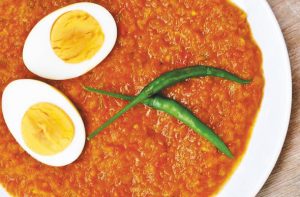Mama’s Punjabi Recipes: Uble Ande Di Turri (Boiled Egg Curry)
Saved under Community, Current Stories, Recipe Corner
Tags: Baytown, Boiled Egg Curry, Clear Lake, Cypress, Desi news, Greater Houston, Houston, Houston Desi news, India, Indian American community, Indian News, Indians in America, Indo-American News, Katy, Mama’s Punjabi Recipes, NRI, pearland, south asia, South India, Sugar Land, Texas, USA
Andewalas (egg hawkers) can be found all over North India offering eggs in a wide variety of ways. Sliced hot boiled eggs sprinkled with spices are big sellers in New Delhi, especially during the winter months. In many Punjabi homes, the most popular way to eat eggs is an omelet with onions eaten with a crispy, hot parantha (crispy flatbread)!
In the last decade in India, egg production has grown tremendously through large scale hen-raising in huge farms which have increased the supply. Large brown and white eggs stacked in cardboard egg crates are sold in stores and even at street stalls, though they are not usually kept refrigerated. Many people say that eggs sold in India simply taste better!
India is a predominantly vegetarian country, but some vegetarians do eat eggs (mostly on doctor’s orders) to supplement their protein intake. Chicken eggs supply protein through essential amino acids, vitamins A, B2, B9, B5, B12, and choline, iron, calcium, phosphorus and potassium. Vitamins A, D and E are in the egg yolk, which also has two-thirds of the recommended daily intake of 300mg of cholesterol. A large egg yolk contains approximately 60 calories; the egg white contains about 15.
Unlike the US, in India egg salad is not only not popular, but it is an unknown dish. Also, most Indian dishes do not use eggs as a base ingredient, like in a soufflé or a pudding or a cake. Eggs are either cooked at breakfast or as a snack or into curries, such as this very popular and simple boiled egg curry. It goes well with rice, but can be eaten with hot rotis too.
Ingredients:
6 large ande (eggs)
1 large pyaaz (onion)
1 medium tamater (tomato) – soft ones are best
1 medium clump of adrak (ginger root)
1 medium kernel of lasan (garlic)
3 cups of water
2 tablespoons of vegetable or olive oil
Tomato paste to taste
Spices (to your taste): namak (salt), mirch (red pepper), haldi (turmeric) and sukha dhania powder (dried coriander seed powder)
Directions:
1. Finely chop the ginger, onions and garlic and brown them in the oil in a saucepan over medium low heat.
2. Chop the tomato in chunks and add to the mixture and stir till the masala is soft and thick. Add the spices to your taste. Add half a tablespoon of tomato paste, to enhance the taste, texture and color.
3. Now add the water and let the gravy thicken up a bit and bring to a rapid boil for 10 minutes so that the ingredients are dissolved and the curry is thick.
4. While the masala is being made, bring the eggs to a boil in a pan and made sure they are hard-boiled.
5. Rinse in cold water, and after the eggs are cool to touch, peel them, then carefully cut them and center yolk length-wise into halves. Carefully arrange the eggs, cut side up, in a large-mouthed bowl.
6. Now pour the curry over the eggs, making sure all of them are covered. Cover the bowl and let it sit for 15 minutes so that the curry will soak in.
7. Using a large spoon or ladle, carefully serve each egg half making sure the yolk doesn’t break. Serve with hot roti or rice.
MAMA’S TIP OF THE WEEK: FOR BEST TASTE, ALWAYS USE INGREDIENTS AT ROOM TEMPERATURE
When it comes to cooking, everyone is in such a rush these days that they simply want to take things out of the fridge to heat and eat them up. This may work well for previously cooked foods like pizza or leftovers, but it does not work for new dishes that are being prepared. Refrigeration cools all the ingredients down so they do not spoil and in the same way, the proper taste does not come out.
For best taste and flavor, be sure to take out the items from the fridge and leave them at room temperature for at least an hour, and preferably more. The true tastes of the vegetables, breads and eggs will start to be activated and they will become easier to handle and the spices will seep in more easily and faster. You will notice the difference once you bite into your final dish!

Shakuntla Malhotra is a skilled cook of Punjabi dishes made in the old-fashioned style that she learnt as a young woman in her ancestral home in Lyallpur (since renamed Faisalabad), India before it became part of Pakistan after the Partition in 1947. People have often admired her cooking for its simplicity and taste that comes with each mouthful. Even in her mid-eighties, she continues to cook daily and agreed to share some of her delectable Punjabi recipes

